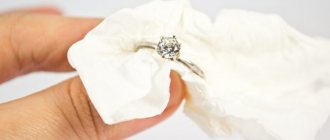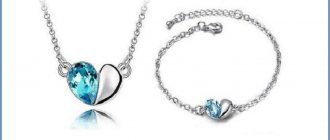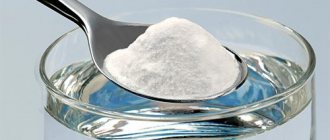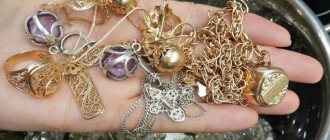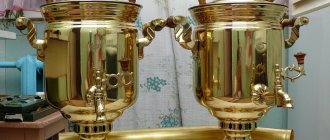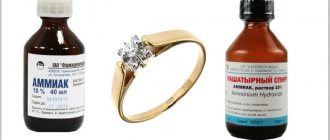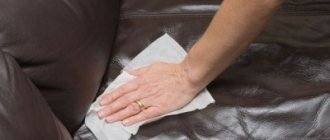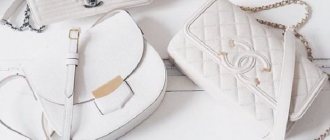Unfortunately, for all lovers of gold jewelry, they tend to darken as they wear them. This is due to both the oxidation of alloys (additives to gold that ensure its hardness) and general contamination. Sweat, oily skin secretions, dirt, detergent residues, cosmetics - all this gradually accumulates on jewelry and deprives it of its former shine. We'll tell you how to clean gold jewelry at home in our article.
Note! If your gold jewelry contains diamonds, we recommend using the cleaning tips in the article “How to Safely Clean Diamonds in Gold at Home.”
Cleaning gold with ammonia
Ammonia can not only revive a person, but also gold jewelry. To do this, follow the steps below.
- Dissolve 5-7 drops of ammonia in a glass of water.
- Immerse the gold jewelry in the solution for 30 minutes.
- Remove the product and rinse it under running water.
- Wipe the jewelry dry, and then wipe with a special microfiber, felt or flannel cloth until it shines.
Note! Ammonia has a pungent odor. When cleaning gold with it, do not forget to ventilate the room well!
Chalk
Chalk is good for cleaning gold, but it should be jewelry without stones or coatings that are easy to scratch. Mix chalk powder with grated laundry soap or ammonia to a thick, dense paste. To apply the mixture well to the surface, use an old toothbrush. Don't forget to wash your jewelry to avoid stains later.
Photo: freelancehack.ru
Table vinegar
This method is suitable for cleaning gold jewelry made of yellow and red gold without any inserts.
Note! It is not recommended to clean white gold with vinegar.
- Make a vinegar solution. To do this, mix 1 part water with 1 part 9% table vinegar.
- Immerse the product in the solution for 5-10 minutes.
- Remove the jewelry and rinse it under the tap with warm water.
- Dry and wipe the product with a microfiber, felt or flannel cloth until it shines.
Soda and foil
Dissolve a couple of tablespoons of baking soda in hot water and place a sheet of regular kitchen foil on the bottom of the container. Place gold jewelry on the bottom and leave to soak overnight. After this, your favorite bracelets and chains need to dry on their own - lay them out on a towel or paper napkin.
Photo: popbela.com
Toothpaste
Take toothpaste without any additives. Avoid using bleach paste as it contains abrasive particles that can scratch the metal. The optimal choice is colorless gel.
- Apply the paste to a cloth.
- Rub the product with a napkin using soft circular movements.
- Rinse the decoration from the paste under running water.
- Wipe the gold item dry and then wipe with a microfiber, felt or flannel cloth until it shines.
Preparing for cleaning
First, gold jewelry is divided into those that have inserts of precious stones, and those that contain only metal.
It is necessary to prepare in advance tools for cleaning hard-to-reach places - a toothbrush or an interdental brush (a brush for cleaning interdental spaces). A container for immersing a gold item is useful if liquid is used for cleaning, as well as a soft cloth for wiping it, preferably flannel or velvet.
To clean some jewelry, prepare special accessories:
- if the ring or bracelet contains organic stones (amber, turquoise, pearls, jet, coral), you will need a small soft sponge to wipe the gold without affecting the insert;
- To clean small crosses and earrings made of white or matte gold, use cotton swabs.
Many of the cleansing liquids have a strong chemical smell and can irritate the skin. It is advisable to stock up on rubber gloves and a medical protective bandage.
Hydrogen peroxide
To clean, you will need 3% hydrogen peroxide, ammonia and liquid soap.
- Mix 250 ml of water, 30 ml of hydrogen peroxide, 1 teaspoon of ammonia and 1 teaspoon of liquid cream soap.
- Soak the jewelry in the mixture for 3-5 hours.
- Rinse the jewelry under the tap.
- Wipe the product dry, and then wipe with a microfiber, felt or flannel cloth until it shines.
Another version of the composition with hydrogen peroxide:
- Mix 250 ml of water with 2-3 teaspoons of hydrogen peroxide and 1.5 teaspoons of liquid soap.
- Place the gold jewelry in the resulting solution for 20-30 minutes.
- Rinse the product under running water.
- Dry the jewelry (or wipe it dry) and wipe with a microfiber, felt or flannel cloth until it shines.
Available means
This category of methods is more suitable for gold, the usual 585 or 750 standard, without stones.
Express methods
To quickly put the appearance of your jewelry in order, you can use the following techniques.
- Dissolve 1 tsp. dishwashing detergent in 200 ml of water. Place a rag in the container and dip the items to be cleaned. Boil for 10 minutes, rinse and dry. You can clearly see the effect of this method in the video.
- This mixture has more ingredients, but it also turns out “more vigorous”. Mix 1 cup warm liquid, 1 tsp. dish soap, 40 g hydrogen peroxide and 1 tsp. ammonia. Immerse the gold in this composition for 20 minutes, after which it must be removed, washed and dried.
- Buy sodium hyposulfite at a pharmacy or photography supply store. It can be used to clean even stubborn stains. 1 tbsp. l. dissolve the chemical in a glass of water and put the jewelry there for 20 minutes. Next you need to rinse and dry the products.
Soak
A long stay in a specially prepared liquid allows you to effectively and effortlessly remove dirt. All you need is to prepare the composition, place the jewelry there, leave for the specified time, and then rinse and wipe dry. Sometimes you may additionally need to clean hard-to-reach areas with a brush or cotton swab.
When implementing such methods, it is worth using ceramic or glass containers.
Let's name the four most famous and effective solutions.
- Ammonia and dishwashing detergent In one glass of boiling water, mix one teaspoon each of dishwashing detergent and ammonia. Place the treasures into the resulting mixture and leave for 1–2 hours.
- soda and foil Place foil on the bottom of the container and place decorations on it. Pour it all over with a soda mixture (1–1.5 tablespoons of soda per 1 glass of water) and leave overnight.
- Salt Regular table salt must be dissolved in liquid (3 tablespoons per 1 glass). It is important to thoroughly stir the salt crystals, otherwise they may damage the surface. Exposure time is at least 8–10 hours.
- Sugar 2 tbsp. l. sugar needs to be diluted in 200 ml of water. Soaking trinkets should be at least 3 hours, and if heavily soiled, you can increase the period to 8.
Polishing
No less effective than soaking, but will take more time and effort.
Powders, soda and any abrasives are not suitable for polishing. They irrevocably scratch the surface, and it becomes impossible to restore its original shine.
You can polish treasures using:
- a piece of flannel, velvet or felt - however, it will take quite a long time to work, and, alas, it will not be possible to clean heavy stains;
- onions - cut the root vegetable in half and wipe the decoration with the cut until clean;
- lipstick - it is advisable to use a colorless lipstick. Apply a small amount of lipstick to the fabric and rub the item;
- eraser - it will be able to remove not only unsuccessful pencil strokes from paper, but also plaque from jewelry accessories. It is enough to wipe dirty places;
- vinegar - soak a napkin in vinegar (5–9%) and treat the product;
- beer and egg white - an unconventional but effective method. Mix 2-3 tbsp. l. beer with 1 egg white and spread with a rag on a bracelet or earrings and polish thoroughly;
- paste - it can be prepared from toothpaste, chalk, grated laundry soap, Vaseline and warm water. All components are mixed in equal parts. Apply the mixture to the surface to be polished and rub gently in one direction. Afterwards, you need to wipe the item with alcohol to wash off the Vaseline.
After any treatment, rinse the jewelry, wipe and dry.
Cleaning items with stones
Values with inserts require special treatment. If the stone is glued, immersion and prolonged contact with liquid may cause the glue to dissolve. Then the pebble simply falls away.
You should also know that stones are different.
- Cubic zirconias, diamonds, topazes, sapphires, peridots, garnets, emeralds, rubies and zircons are hard stones, and they can easily withstand cleaning by almost any means.
- Corals, pearls, malachite, turquoise, opal are soft rocks that require a reverent attitude. It is unacceptable to use brushes, toothpaste and other similar tools and substances. They also do not tolerate moisture well. It is not allowed to rub them with ammonia, as it will make the inserts cloudy. Pearls categorically do not tolerate acid, so you will have to immediately forget about vinegar and lemon.
Now let's talk in more detail about what recipes and methods are allowed.
A universal composition for any type of material is a warm soap solution. In the case of hard stones, you can use a soft brush, and for sensitive rocks, use a cloth.
For caring for hardwood, the following method can be recommended. Shake a teaspoon of ammonia in ⅓ glass of water and immerse the accessories there. After a few minutes, shake the glass to remove dirt in hard-to-reach places. After 10 minutes, the treasures need to be removed and washed. This technique will help get rid of difficult stains.
To remove greasy deposits and stains from diamonds and emeralds, use gasoline. Soak a rag in the fuel and rub the stone. You can do the same with hydrogen peroxide.
Corals, turquoise and hard rocks can be polished with a cotton pad soaked in alcohol.
Removing dirt from white gold jewelry
The addition of silver, nickel or palladium, as well as rhodium plating, takes away the yellow tint from gold. These products require careful handling due to the fact that the rhodium layer is very thin and there is always a risk of damaging the coating. Therefore, it is forbidden to use mechanical cleaning methods and be very zealous when polishing.
You shouldn’t increase the time the jewelry spends in the cleansing mixture.
We can recommend the following options:
- Ammonia and hydrogen peroxide are mixed in a ratio of 1 to 2. Place jewelry in this cleaner and leave for 30 minutes. All that remains is to rinse and wipe.
- A mixture of ammonia and shampoo will be softer. To prepare it, combine ammonia and water in equal quantities, add a little shampoo to them. Exposure time – 30 minutes.
- The recipe we already know with sugar cleans well. Let's remember: 2 tbsp. l. per glass of liquid. Soak for 8–10 hours.
Cleaning Matte Gold
The matte effect is achieved through a special grinding technology. To avoid damaging the surface, carefully choose your treatment methods.
First of all, you should avoid any abrasives and rough brushes, i.e., anything that can scratch the metal.
This mash will help remove dirt: you need to prepare a liquid paste from water and lime (1 coffee spoon). Next, add a small pinch of salt and half a coffee spoon of soda. The finished mixture will have to sit for 3 days.
After this time, dip the jewelry into the mixture and wait 4 hours. Then rinse them and blot them with a cloth.
A 25% ammonia solution will also work. You need to place jewelry in it for several hours. Then rinse and dry your treasures.
Attention! This method is prohibited for items with inserts.
Cleaning gold with GOI paste
GOI paste is a special tool for polishing metals, developed by the State Optical Institute (abbreviated as GOI). There are several pastes with numbers from 1 to 4. Numbers 3 and 4 have rather large particles; they are not suitable for cleaning gold. Numbers 1 and 2 help polish the metal to a mirror effect. Simply apply the paste to a cloth and rub the gold jewelry with it. After treatment, the product should be rinsed under running water and wiped dry.
Note! GOI paste is only suitable for cleaning red and yellow gold without inserts! White gold and inlaid items cannot be cleaned with this paste.
Why does gold turn black?
It is not the gold itself that darkens, but the alloys or alloys added to it for strength (pure noble metal is too soft to make jewelry from). Typically, tarnish and staining are caused by copper and nickel, which react with oxygen and sulfur oxides. Other reasons for tarnishing of gold jewelry:
- excretion of sweat and other metabolic products through the skin;
- constant exposure to chemicals found in perfumes, deodorants, hairspray and other cosmetic, hygiene or medicinal products.
Cleaning gold with citric acid
Cleaning with citric acid is recommended for jewelry made of red or yellow gold.
- Dissolve 1/4 teaspoon of citric acid in 200 ml of water. Make sure the crystals are completely dissolved!
- Dip gold earrings, rings or chain into the solution for 5-7 minutes.
- Rinse the jewelry under the tap.
- Dry the gold item or wipe it dry. After this, give it a final wipe with a microfiber, felt or flannel cloth for shine.
Note! White gold items cannot be cleaned with citric acid.
Causes of pollution
The sources of unsightly spots and darkening are:
- chemicals - soap, household chemicals, creams: this is especially true for rings;
- sweat and fat secretions are natural for humans, but cause harm to products made of precious metal;
- dust and dirt surround us in everyday life and inevitably end up on all objects.
Gold is a soft metal that is easily scratched and deformed. Therefore, to improve performance characteristics, other materials are added to the precious one. Although damage is still inevitable. At first, minor flaws are not visible to the naked eye, but gradually the network of scratches grows, and because of this, the jewelry becomes dull and loses its luster.
Cleaning gold with alcohol
Regular medical alcohol is applied to a cotton pad and the product is wiped. This way you can clean jewelry made of yellow, red or white gold with or without inserts. After treating with alcohol, the jewelry is washed with clean water, wiped dry and rubbed until shiny with a microfiber, felt or flannel cloth.
For complex jewelry, openwork or composite, such as chains, you can use a water-alcohol solution. Mix alcohol and water 1 to 1 and soak the decoration in it for a few minutes. Afterwards, be sure to rinse with water.
Prevention
To make rings, bracelets, earrings and chains sparkle and delight you with their appearance, you need to adhere to simple operating rules.
- Remove jewelry before dirty work, contact with household chemicals, sports and cosmetic procedures.
- If moisture gets on the gold, be sure to wipe it with a cloth.
- Clean your accessories at least once every 2 months.
- It is better to store jewelry away from sunlight in a wooden box with soft walls.
How to clean Fairy gold
A well-known brand of dishwashing detergent perfectly breaks down grease. On many sites you can find advice to boil jewelry with the addition of this product. We do not recommend using such aggressive methods. Soaking is safer.
- Make a solution by mixing 200 ml of water, 1 teaspoon of Fairy, 1 teaspoon of ammonia and 40 ml of hydrogen peroxide. Mix well.
- Immerse the decoration in the solution for 10-20 minutes.
- Remove the jewelry and rinse under running water.
- Dry and wipe with a microfiber, felt or flannel cloth.
Jeweler's cleaning tips
If you need to clean your gold bracelet yourself at home, you should first examine the product. It is necessary to understand the nature of the product’s coating, design and silhouette, the presence of ornaments and stones. And only after that a suitable effective way to clean plaque or dirt is selected.
There are several recommendations from jewelers:
- If there are large stones on a gold bracelet under which hard-to-reach dirt accumulates, you must first soak the product in a soapy solution. After an hour, you can add ammonia to add shine and leave for another hour. In this case, the water should be warm enough. After this, the plaque can be easily removed with a soft cloth, and under the minerals you can carefully clean with a toothpick;
- A gold bracelet inlaid with small minerals can be easily cleaned with chalk, GOI paste or tooth powder. You just need to carefully walk your fingers over the minerals, and they will shine with purity faster than gold;
- There are gold items whose configuration does not allow dirt to be easily cleaned due to tricky design or intricate elements. This is where either a professional solution for cleaning gold metal at home or a specialist can help.
How to clean gold with Mystic powder
Biotrim Mystik is a cleaning powder from the Greenway network company. The manufacturer claims that the product works effectively on glass, crystal, teapots, coffee makers, porcelain and even helps remove stains from things. Applications include cleaning jewelry, including gold and stone jewelry.
- To clean, you will need to dilute 1 teaspoon of product in 1 glass of hot water.
- Place decorations in the solution. Explication time is from 5 to 15 minutes.
- Afterwards, rinse the jewelry with clean water, dry and wipe with a napkin until it shines.
Additional recommendations
It is better to entrust the cleaning of antique gold items that have become very dark and have a complex relief with inserts of stones to professionals. Jewelry workshops have special equipment - very small brushes, ultrasonic devices that remove dirt from even the most inaccessible corners. After a cleaning procedure by a professional goldsmith, gold looks like new, but the cost of the work is certainly higher than the cost of products used for home cleaning.
What to do if the decoration is with stones
Jewelry with stones of organic origin is wiped with ammonia, cologne or gasoline using a cotton swab, grabbing only the gold and not touching the inserts. Some companies offer preparations for rinsing gold jewelry with organic matter. These are Silbo (Germany) and the already mentioned Connoisseurs (USA), as well as Hagerty (France).
It is also advisable to use special products to clean gold jewelry with inorganic stones. Aladdin, in particular, does this very well.
How to clean gold with stones at home
Features when cleaning white gold
White gold usually contains nickel, manganese or palladium as an alloy and is topped with rhodium to enhance shine and durability. To avoid damaging your jewelry, clean without mechanical impact, choosing gentle methods:
- Wash them in soapy water using a soft small sponge.
- Soak a soft cloth in ammonia and gently scrub on all sides.
- Clean your jewelry with non-abrasive gel toothpaste.
After any type of cleaning, rinse the gold with clean water and dry with a soft cloth.
How to clean white gold
How not to clean gold
To clean gold of any kind, you should not use:
- bleaches containing chlorine;
- acetone and any paint and varnish solvents;
- Strong kitchen grease removers (e.g. oven cleaners).
Products made of matte gold, like white ones, cannot be cleaned with any GOI powders or pastes, since they are softer than ordinary gold and can easily be damaged.
Pollution prevention
To ensure that the need for cleaning gold arises as rarely as possible, treat items made of precious metal with care:
- remove rings and earrings when cleaning the house, working in the garden or vegetable garden, cooking, as well as when carrying out cosmetic procedures at home or at a cosmetologist (when applying cream, peeling, manicure);
- do not wear gold at work if there is a risk of scratching or hitting it;
- Do not take a bath or shower wearing gold jewelry;
- leave at home before visiting the gym, swimming pool, sauna, solarium and hot beach.
There are also rules for storing gold jewelry:
- keep them in a dry place out of direct sunlight;
- The best option is a special box with many compartments or dividers installed in the drawer. In any case, gold products should not come into contact with each other so as not to create minor mechanical damage;
- Do not store gold in cardboard boxes. This material contains sulfur, which harms it, being one of the strongest oxidizing agents.
Proper care of gold preserves its impeccable appearance for a long time. Noble metal is vulnerable: it cannot be cleaned with any means that removes dirt and grease. However, it is quite possible to cope with this task at home, returning it to its original sparkling shine.
Cleaning white gold with sugar
White gold jewelry, including those with stones, can be cleaned with a weak sugar solution. For this:
- Mix 2-3 teaspoons of sugar with 250 ml of water until the crystals dissolve.
- Soak the decoration in the solution for 12-24 hours.
- Rinse it under running water.
- Wipe dry and polish with a microfiber, felt or velvet cloth.
Using the same recipe, you can clean jewelry made of yellow, red and combined gold.
It is recommended to clean jewelry once every 2-3 months. If you are not removing items (such as a wedding ring or earrings), more thorough cleaning may be required. We recommend contacting a jewelry workshop. There, rings, earrings or other jewelry are guaranteed to be restored to their original appearance by removing all dirt. Polishing is carried out to remove minor scratches. Also, the jeweler always checks the strength of the stones if the jewelry has inlay.
Methods for purifying gold
The method used for cleaning should be chosen based, first of all, on the characteristics of the treasure itself: the alloy from which it is made, the presence of a coating, whether it has a matte or glossy surface, whether it has inserts.
There are several options for returning the yellow metal to its former glory.
- Taking it to a jewelry workshop is the least labor-intensive, but at the same time expensive option. Regularly processing large quantities of items can cost a pretty penny. However, if the earrings or ring are very expensive, fragile, or you are not sure that you know their composition, then it is still better not to take risks and entrust the matter to a master.
- Buy a professional product - they are presented in a large assortment in jewelry stores, you can also look in the departments of household chemicals. Their forms are different: creams, pastes, sprays, wet wipes. You should be more careful when purchasing, since there are often situations when a product is suitable for one type of jewelry, but is strictly contraindicated for another.
- Buying an ultrasonic cleaner is an expensive purchase, but you will only have to spend money once, unlike going to a specialist or buying special products. Please note that not all products can be cleaned this way. Some stones cannot withstand exposure to ultrasound and may crack.
- Using improvised means is the cheapest way. Additionally, most of the ingredients for these mixtures can be found at home. Among the disadvantages, it would be fair to note that the result is not always predictable: you often have to act at your own peril and risk. No one can guarantee how the metal will behave under such procedures, so you should approach the choice of recipe with caution.
Under no circumstances should you wash gold and silver valuables in the same solution. Otherwise, they will become covered with a white coating that is difficult to remove. To clean silver jewelry from blackness and other dirt, take a separate bowl.
Rules for wearing, caring for and storing gold bracelets
How to protect a gold bracelet from darkening and dullness:
- hide the decoration from direct exposure to the sun;
- hide jewelry before cleaning, cooking, visiting a bathhouse or sauna, spa center or swimming pool;
- dry clean the gold bracelet after contact with moisture;
- try to wear the jewelry as carefully as possible - protect it from impacts, heat and moisture;
- keep jewelry separately so that they do not injure each other;
- Do not use plastic or cellophane to store your gold bracelet: the metal may turn black in the absence of oxygen.
Chemical compositions
If you don’t have the time or desire to prepare the products yourself, ready-made professional compositions designed specifically for cleaning gold will come to the rescue:
- Adamas (items with pearls, amber and some precious stones cannot be cleaned);
- Aladdin (gold jewelry is cleaned in a matter of minutes, while the shine of the stones is restored);
- HG (with the help of a brush and tweezers included, blackness and all types of dirt are removed);
- Town Talk Brilliant Gold Polishing Cloth (polishing cloths fight stains and protect products from harmful factors for a week after use);
- Unicum (cannot be used on painted items).
Is it possible to polish gold yourself?
We strongly do not recommend doing this without the necessary training and equipment. The reason is that most of the chemical compounds sold supposedly for “polishing” will only give an abrasive effect. Incorrect calculation of the dose of the substance and excessive effort will simply cause more scratches, abrasions and unsightly defects that cannot be corrected.
As for “factory” processing, it is possible to restore rhodium plating on gold only in laboratory conditions. The jewelry is first cleaned, polished, and then placed in a rhodium saline solution and a galvanic bath. Under the influence of electricity, “spraying” is formed, which is simply impossible to achieve using manual methods or reagents.
Why does gold jewelry darken?
There are several reasons, each of them is directly related to the physical properties of the metal:
- Low-quality alloy - unfortunately, unscrupulous sellers periodically pass off 375 standard and lower as 585 standard. It is often impossible to check this without an examination, and only over time do characteristic spots appear on the product.
- The polishing layer has worn off - most jewelry today is coated with rhodium for additional shine. Over the years, it wears out, and the surface becomes vulnerable to oxidation processes and other negative factors.
- Constant contact with a sweat-fat environment is the most common cause of darkening. Various diseases, taking antibiotics and other circumstances change the acid balance in the body, which is why gold can suffer when worn every day.
- Reaction to iodine and aggressive household chemicals. That is why it is recommended to remove all jewelry before taking a bath, washing dishes, etc. Potassium compounds can also be present in tap water in small doses, but over time they appear on the metal.
Only the last two examples will allow you to effectively clean gold jewelry from darkening or plaque. In the case of a low-grade alloy, nothing will help - such a product has already “served” its usefulness and will have to be thrown away. But it is quite possible to restore the polishing layer of rhodium, but this should be done by a professional jeweler with experience.
Cleaning items with stones
When there are stones on a gold product, you should be careful in choosing the cleaning method. Some types of precious stones (turquoise, amber, opal, etc.) are afraid of water and can lose their color or become deformed from excess moisture. In addition, you should not soak gold jewelry, the stones to which are attached with glue.
A simple procedure will help to add shine to gold and restore its former attractiveness. You just need to soak a cotton swab or cloth in cologne or alcohol and wipe the metal surface. Then do the same only with a cloth soaked in water. And complete the procedure with dry wiping.

